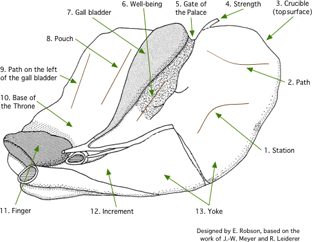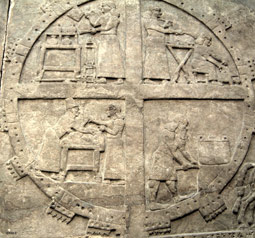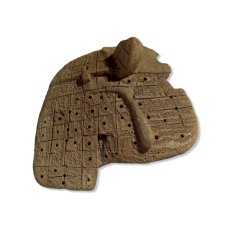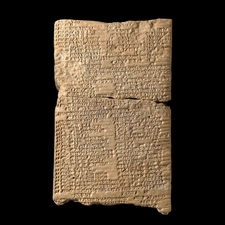Sacrificial divination: confirmation by extispicy
Observational divination inferred the gods' will through close examination of portents TT from the world around. The gods could also send messages though dreams and divinely inspired utterances, or oracles TT , to any citizen of Assyria. But sometimes it was not enough to wait for the gods' messages. The king might need to resolve a pressing political problem, or he might not be certain whether to trust the human intermediary of a divine oracular pronouncement. Under those circumstances he commissioned a sacrificial divination, or extispicy, to obtain a divine yes-no answer to a question he put to the gods. His haruspex (bārû, literally "seer") examined the entrails of a sacrificed ram for ominous marks, counting up good and bad and declaring the most prevalent as the divine response to the king's query.
Ancient origins

The liver of the sheep, with the zones considered ominous in Neo-Assyrian royal extispicy. View large image.
Extispicy was not an innovation of the Neo-Assyrian court. In the late third millennium BC, when years were named after contemporary political events, we find for instance, "The year in which the en-priestess of Enlil PGP was chosen by a goat" (Naram-Suen of Akkad PGP , c.2300 BC) or "The year in which king Ur-Namma's son was chosen by a goat as the en-priest of Inanna in Uruk PGP " (Ur-Namma of Ur, c.2100 BC). The goat in question was presumably not set free amongst the potential appointees to butt or nuzzle its favourite candidate. Rather, it must have yielded divine confirmation of a royal selection when diviners cut it open to reveal favourable portents on its organs. In the eighteenth-century kingdom of Mari, the senior haruspex Asqudum was a member by marriage of the royal family. He regularly corresponded with the king, giving explicitly political advice in interpretation of the extispicies he had performed at his royal client's behest. And when the queen reported on oracular pronouncements made by cultic personnel or servant girls, she usually included in her letters to the king a sample of the oracle's hem and hair. If the king chose, he could give them to Asqudum or another haruspex to incorporate in an extispicy ritual to test the veracity of the supposedly divine utterance. In the sixteenth-century Babylonian city of Sippar PGP , a priest called Ur-Utu commissioned extispicies at New Year TT to determine whether he and his family would remain "alive and well" over the coming twelve months.
Preparing for extispicy: prayer and ritual

A haruspex and his assistant preparing a ram for sacrificial divination in a military camp; detail of the stone decoration of Assurnasirpal's Northwest Palace in Nimrud, room B panel 8 (top), c.860 BC (BM ANE 124548). Photo by Eleanor Robson. View large image.
The haruspex did not simply cut open the nearest available animal as soon as the king asked a question. Surviving prayers, rituals TT , and letters all indicate that careful preparation was necessary. The chosen sacrifice (a lamb, sheep, goat, or ram) had to appear as healthy and fit as possible. Ominous signs of internal imperfection were meant to be summoned during the course of the ritual, not supposed to already exist inside a diseased animal. The haruspex himself, his assistants and attendants, and the site of the sacrifice all had to be ritually clean. Purification TT could take the form of washing, shaving, fumigation TT with incense TT , and of course prayer. When the haruspex laid out his client's query on a tablet TT or papyrus TT before Šamaš PGP and Adad PGP , the gods of divination, he routinely asked them to overlook the possibility that any part of this preparation might have been imperfectly performed, or inadvertently contaminated by casual passers by, while they "judged the case" and wrote their decision inside the offering.
Whether or not there were specially designated areas for extispicy within temples, the ritual had to be performed outside (perhaps in a courtyard) under the gaze of Šamaš the sungod and Adad the weather-god. The Assyrian kings also took haruspices on military campaign with them. The letter of Esarhaddon's grandfather Sargon PGP to the god Aššur PGP about the events of 714 BC recalls that, after favourable celestial omens were seen, Sargon mustered his army "upon the previous approval of the warrior Šamaš, who wrote encouraging signs on the exta TT ". Palace bas-reliefs also show haruspices at work in military encampments. But wherever they took place, extispicies were not performed under cloudy skies, when Šamaš was not present. If the ritual continued after sunset, the haruspex offered a prayer to the gods of the night – the moongod Sin PGP and the stars overhead – asking them to keep watch over the proceedings.
Examining the exta
The sacrifice and internal examination must have been a very messy, bloody business. The haruspex had at least one scribe on hand – a "reporter TT " – to record his observations of damage, anomalous growths, and malformations. The team began with a minute inspection of about a dozen zones on the surface of the animal's liver and gall bladder, in anticlockwise order, and then moved on to the lungs (treated as a single unit). Clay models of livers and lungs, carefully labelled in cuneiform writing, were used to teach the elements of extispicy to apprentice haruspices from at least the early second millennium BC until the Neo-Assyrian period. They are invaluable for modern scholarship too, enabling us to identify exactly which phenomena were considered potentially ominous. Naturally, the technical terminology evolved over the millennia, but for the liver Esarhaddon and Assurbanipal's haruspices used the scheme shown in the diagram above.

Clay model of a sheep's liver from the early second millennium BC, inscribed with the ominous significance of marks found on different parts of its surface. © The British Museum. View large image on the British Museum's website.
Of lesser importance were the breast-bone, kidneys, vertebrae, and heart. Often the haruspex simply checked whether these appeared normal or not, and counted the number of coils made by the colon (great intestine). All over the exta, the haruspex also looked for random fortuitous markings – holes, marks, and abrasions in particular shapes and configurations. "Foot"-marks (like feet) and "weapon"-marks (like arrow-heads) were particularly common but "request"-marks (whatever they looked like) and "cross"-marks (in fact like the modern letter Y) were also noted.
Surviving sources never describe cleaning up at the end of the extispicy but the haruspex and his assistants must have needed a thorough wash. Neither do we know what typically happened to the eviscerated carcass of the sheep. Did it have to be ritually disposed of, or was it considered fit for human consumption?
Reading and interpreting the omens

A list of omens taken from the exta of a sacrificed sheep, from the early second millenium BC (BM ANE 096948). Photo © The British Museum. View large image on the British Museum's website.
In general, a favourable omen consisted of healthy organs on the right side of the sacrificial animal's body and damage or malformations on the left. But in theory it was not as simple as that. Detailed descriptions of observations and the portents they entailed were systematically catalogued in a handbook called bārûtu "Extispicy". In the Neo-Assyrian period it perhaps ran to as many as 99 standard tablets grouped into nine chapters according to the internal organ examined, with a final section of commentary and interpretation. Only about half of the series has been published in modern scholarly editions to date, but this extract from Tablet 6 of the chapter on the Station, or reticular impression of the liver, gives some sense of its structure and complexity:
If a Design is drawn from the centre of the top of the Station to the Gate of the Palace and a "weapon"-mark points parallel to it: a leader will leave his country.
If a Design is drawn from the centre of the top of the Station to the Gate of the Palace and a "weapon"-mark points to it: a leader will enter the country.
If a Design is drawn from the centre of the Gate of the Palace to the Station: the gods have heard the wailing of the land.
If a Design is drawn between the Station and the Path: a god will request an emblem or a censer from a man.
If a Design is drawn twice between the Station and the Path: a man's wife will have her husband killed.
If a Design is drawn three times between the Station and the Path: a man's wife will write again and again about killing her husband, "Kill my husband and marry me!"
During Esarhaddon's reign and for most of Assurbanipal's, the haruspices did not, as far as we know, record their observations on clay tablets for the royal archives; only the queries they posed before the sacrifice survive. However, from at least 652 BC onwards, Assurbanipal had his scholars write summary reports of their extispicies, which allow us to correlate theory and practice. The best preserved (SAA 4: 280, 296, 306, 317, 320) show that while the "reporters" recorded all the key ominous features of the exta, favourable and unfavourable, they almost always attached omens only to their unfavourable observations and only (but not invariably) when the overall outcome of the extispicy was unfavourable.
Haruspices and the king
Some historians have argued for the low status of extispicy in the Neo-Assyrian court because there are so few surviving letters from haruspices to the king (SAA 10: 173-184). In fact this points to the contrary conclusion: because the king himself commissioned extispicies, his haruspices had no need to make formal approaches to him in writing as the other scholars did. That suggests that they were allowed direct face-to-face contact to discuss their findings with the king. Given Assurbanipal's scholarly interests in extispicy, he may have started to commission formal written reports so that he could scrutinise the evidential basis for his haruspices' advice. Nevertheless, extispicy remained the Assyrian king's most trusted means of divine communication and political decision-making. Medical diagnoses, prognoses, and treatments were routinely confirmed by extispicy, as chief physician TT Urad-Nanaya PGP accepts (SAA 10: 315). Senior cultic and courtly appointments were still decided on the basis of sacrificial divination, as they had been for nearly two millennia. No move in Assurbanipal's painful war with his treacherous brother Šamaš-šumu-ukin PGP was made without consulting Šamaš. When the king sought the gods' support for an action, sacrificial omens were the last type to be consulted, not because they were the least important but because they were decisive: the last word in divine advice.
Further reading
- Lambert, 'Qualifications of Babylonian diviners', 1998
- Starr, Queries to the Sungod, 1990, introduction
- Starr, 'Chapters 1 and 2', 1992
- Steinkeller, 'Of stars and men', 2005
- Veldhuis, 'Reading the signs', 1996
- Guinan, 'Left/right symbolism', 1996
Content last modified: 17 Apr 2024.
Eleanor Robson
Eleanor Robson, 'Sacrificial divination: confirmation by extispicy', Knowledge and Power, Higher Education Academy, 2024 [http://oracc.museum.upenn.edu/saao/knpp/essentials/sacrificialdivination/]